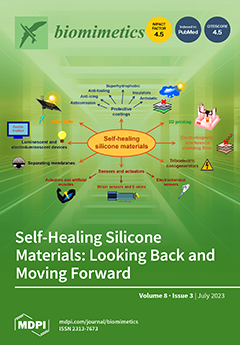Open AccessArticle
Biomimetic Design of a Tendon-Driven Myoelectric Soft Hand Exoskeleton for Upper-Limb Rehabilitation
by
Rodrigo C. Silva, Bruno. G. Lourenço, Pedro H. F. Ulhoa, Eduardo A. F. Dias, Fransergio L. da Cunha, Cristiane P. Tonetto, Luis G. Villani, Claysson B. S. Vimieiro, Guilherme A. Lepski, Marina Monjardim and Rafhael M. Andrade
Cited by 2 | Viewed by 1917
Abstract
Degenerative diseases and injuries that compromise hand movement reduce individual autonomy and tend to cause financial and psychological problems to their family nucleus. To mitigate these limitations, over the past decade, hand exoskeletons have been designed to rehabilitate or enhance impaired hand movements.
[...] Read more.
Degenerative diseases and injuries that compromise hand movement reduce individual autonomy and tend to cause financial and psychological problems to their family nucleus. To mitigate these limitations, over the past decade, hand exoskeletons have been designed to rehabilitate or enhance impaired hand movements. Although promising, these devices still have limitations, such as weight and cost. Moreover, the movements performed are not kinematically compatible with the joints, thereby reducing the achievements of the rehabilitation process. This article presents the biomimetic design of a soft hand exoskeleton actuated using artificial tendons designed to achieve low weight, volume, and cost, and to improve kinematic compatibility with the joints, comfort, and the sensitivity of the hand by allowing direct contact between the hand palm and objects. We employed two twisted string actuators and Bowden cables to move the artificial tendons and perform the grasping and opening of the hand. With this configuration, the heavy part of the system was reallocated to a test bench, allowing for a lightweight set of just 232 g attached to the arm. The system was triggered by the myoelectric signals of the biceps captured from the user’s skin to encourage the active participation of the user in the process. The device was evaluated by five healthy subjects who were asked to simulate a paralyzed hand, and manipulate different types of objects and perform grip strength. The results showed that the system was able to identify the intention of movement of the user with an accuracy of 90%, and the orthosis was able to enhance the ability of handling objects with gripping force up to 1.86 kgf.
Full article
►▼
Show Figures






